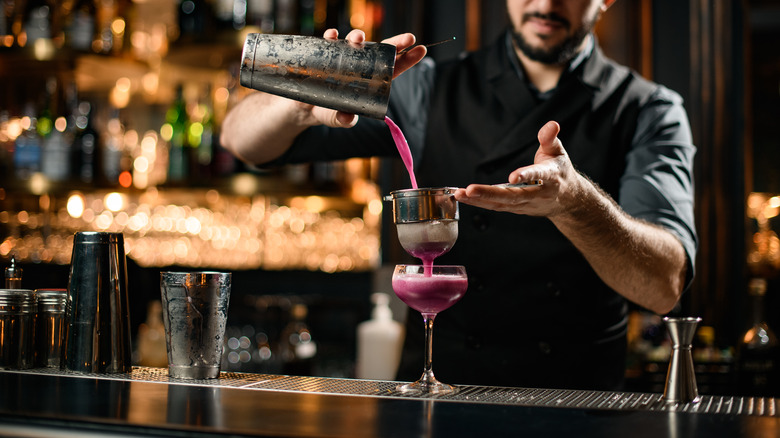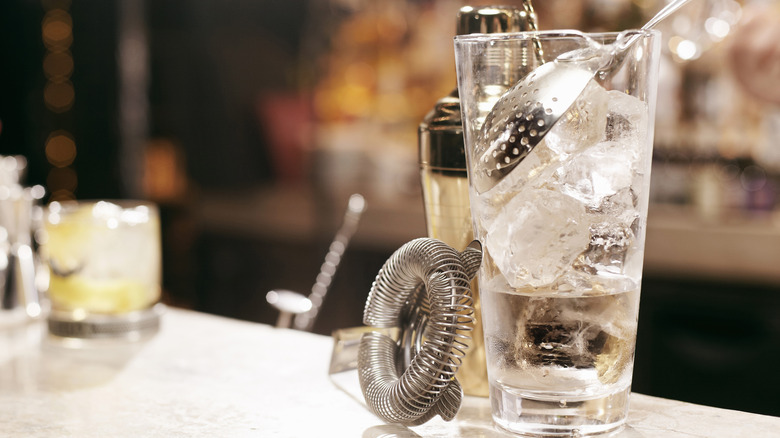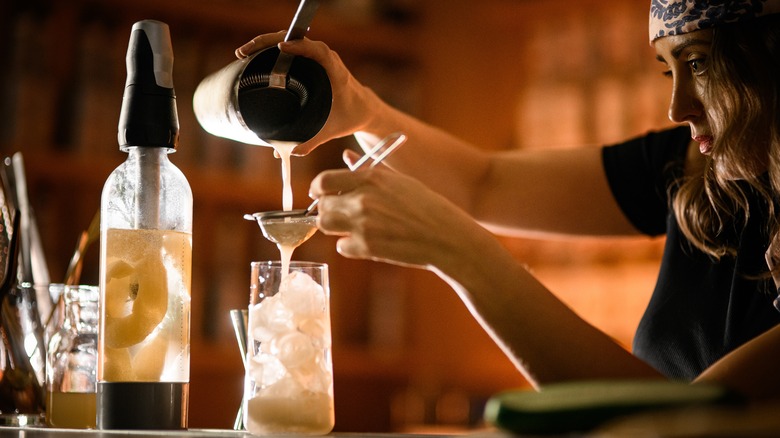Double Strain Your Cocktails For The Smoothest Results Possible
Are you a cocktail connoisseur looking to upgrade your skills? Well, one crucial part of mastering mixology is the ability to pour smooth drinks. You can use the right blend of ingredients in exactly the right quantities, but if it hits your tongue and you pick up on shards of ice, pulp, or herbs, it can distract from the overall experience. Luckily, there's a simple trick to making those beverages smoother than silk.
So what's the secret? Double straining. Straining is nothing new in the world of mixology; bartenders are used to crafting cocktails with strainers. Typically, they use either a Hawthorne or a Julep strainer. The Hawthorne has a handle with a flat metal disc surrounded by coils, while a julep resembles a large spoon with small holes. Mind you, we're not reinventing the wheel — you should still use one of these to start. But we also recommend adding a fine mesh sieve after the initial strain. This eliminates any tiny ice crystals and creates a more uniform, delicate texture.
As you can see, double straining is just as it sounds. However, there are some intricacies worth noting. After all, mixology is an art, and creating the perfect cocktail requires skill. Plus, not all cocktails require a double strain. Some benefit greatly, while others don't need filtering at all. So, if you truly want to master mixology, read on for the ins and outs of double straining.
How to double-strain cocktails
Double straining is obviously a two-step process. The first round can be done with a Hawthorne or Julep filter, depending on the type of mixer you're using. Hawthorne filters work best with tin shakers. And if you've purchased a cocktail-making kit, chances are it came with this style. Meanwhile, julep strainers are better suited to mixing glasses because they fit snugly inside the rim for easy pouring.
After pouring the cocktail through the first strainer, let it pass through a second, much finer filter. In bartending, this utensil is known as a fine mesh strainer or — no surprise here — a mesh cocktail strainer. Although you use two strainers, you don't need to dirty several glasses. You can easily streamline the process by stacking one filter on top of the other. Hold the first strainer against the mixing glass or cocktail shaker. Place the second over your serving glass and pour. The super smooth liquid will flow directly through both filters and into your glass without any unwanted gunk. And bonus: The mesh sieve does a great job of funneling the fluid into the glass, so you're less likely to deal with spillage.
When to double-strain your cocktails
Now that you know how to make the smoothest cocktails in town, you'll probably want to show off your skills. That said, don't go around double-straining any and every drink — not all cocktails are meant to be smooth. Of course, frozen beverages should always be poured directly into the glass, and you should avoid shaking and straining anything with bubbles as it will flatten the drink. Lastly, spirit-only beverages like Manhattans or Negronis can be stirred and gently strained once.
As a rule of thumb, only double-strain cocktails that are shaken, especially if they're served up. Cosmos fit this profile, and when double strained, you won't get any ice chips diluting the drink. The double strain is also effective against unwanted herb or fruit chunks. Passing that mojito through a second filter means you won't get any mint stuck in your straw — or teeth, for that matter. This technique also works wonders for egg white cocktails like Pisco sours. The double strain creates a super smooth foam worth writing home about (even if you were home when you made it).
Bear in mind that, like any artwork, bartending can be a subjective skill. Double straining can elevate or detract from a drink, depending on the beverage and personal preference. So, tuck this technique up your sleeve and pull it out when you want to experiment. And when you're craving the smoothest cocktail possible, reach for that fine mesh sieve.


